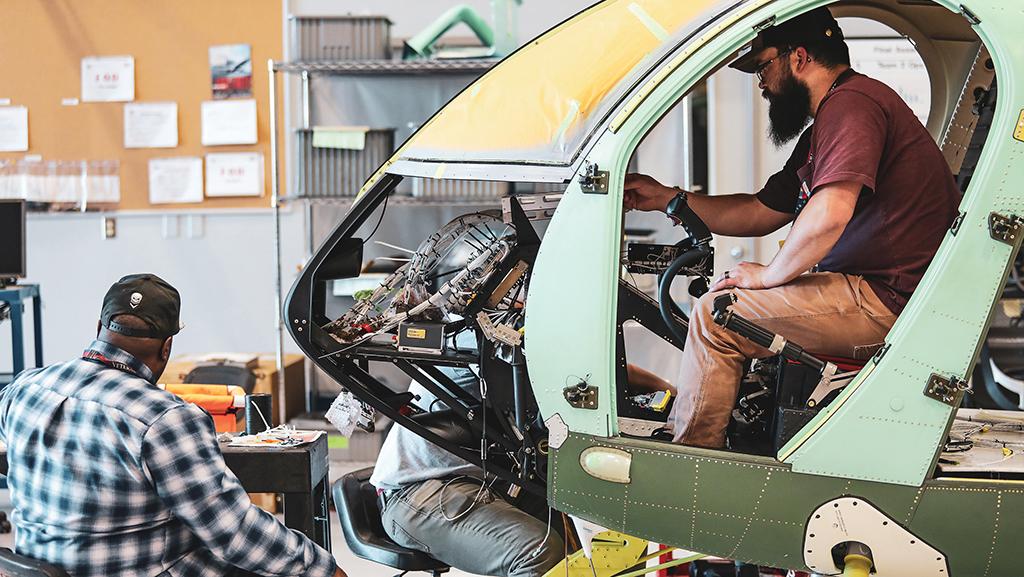
Production in Mesa is currently focused on the MD500 family of aircraft for military and commercial customers.
After a year under new ownership, MD Helicopters has reestablished production and begun filling its backlog with orders from military and commercial customers for its single-engine light helicopters.
The Mesa, Arizona-based company is eager to turn around 15-20 years of “turmoil” after its various and storied ownerships and to rebuild support for its installed base of more than 1,700 aircraft operating around the world.
- $50 million spent restoring supply chain
- Nigerian Army has purchased 12 armed MD530Fs
- OEM still mulling MD902 production options
“For years the company didn’t pay a lot of attention to keeping those guys flying,” Brad Pedersen, MD Helicopters’ president and CEO, told journalists on Oct. 3 as the company marked one year under new management.
“Now we are talking about functional improvements to our aircraft, working with our supply base to get a good state of production of spares and to attract and retain the most capable, qualified employees that we can,” Pedersen said.
Pedersen was drafted in by a consortium of MBIA Insurance, Bardin Hill Investment Partners LP and MB Global Partners, who snapped up MD Helicopters through a bankruptcy sale last September, swapping the debt they were owed for equity in the company.
Today, production is focused on the MD530 platform, which continues to be popular despite that aircraft’s 60-year heritage—its original design dates back to the days of Howard Hughes’ OH-6 Loach light observation helicopter developed for the U.S. Army.
The MD530’s performance and teardrop-shaped fuselage has earned it status with utility and law enforcement operators as well as military customers who use the type for training and light attack missions.
The company has recently achieved a successful sale to the Nigerian Army for 12 Cayuse Warrior armed variants, and it has also secured orders for six aircraft from an existing Middle Eastern military customer as well as upgrading of their fleet. There are also orders for 11 from the commercial market.
These orders have helped to fill 2024’s production slots, with MD Helicopters planning to deliver around 22 aircraft, Pedersen said. But there is room for expansion, with plans to build white tails so customers can acquire aircraft urgently if needed.
The ambition is to reach a production rate of 50 machines annually, a far cry from just five aircraft delivered in 2022.
Rebuilding production has not been easy: The company has had to rebuild its supply chain, with nearly $50 million spent on a series of agreements with suppliers on purchase orders over the past year.
The company has also identified its top 1,000 in-demand parts—from the 30,000 found in its family of aircraft—and is currently satisfying deliveries of around 80% in any given month. The company wants to achieve a 100% delivery rate by this time next year.
Currently, the company has no plans to restart production of the NOTAR (no tail rotor) anti-torque-system-equipped 520N or the extended fuselage 600-family aircraft, but Pedersen said efforts are underway to continue supporting the 130 aircraft of those models still operating.
MD Helicopters has just qualified a new manufacturer to produce the fan blades for the NOTAR system, and work is underway with another supplier for new tail booms for NOTAR-equipped aircraft. The company is also offering an engine upgrade program for the 520N with the Rolls-Royce 250-C30 powerplant.
Pedersen has also said the company will make a decision in the coming weeks on the twin-engine MD900/902 Explorer family of helicopters, also equipped with NOTAR—although the prospects are not promising.
Out of production for a decade, there have been calls from potential customers for new-build aircraft, recognizing the type’s low-noise signature and safety on the ground thanks to its lack of a tail rotor.
“I would like to see [the MD902] back in production someway somehow,” Pedersen said, “but it’s an extremely large investment for us to do that.”
Pedersen said he wants to be able to support operators still flying the MD902, but added it has even been a struggle to find qualified suppliers who can support the fleet.
Meanwhile, efforts are underway to further develop the MD530 platform. The company is developing a crashworthy fuel system for the aircraft as well as a new glass cockpit upgrade for retrofit into older models, and additional improvements are in the cards, Pedersen said.
“The 500 series is loved by customers for a lot of reasons: simplicity, handling qualities, responsiveness, agility and its safety are paramount,” Pedersen said. “We want to keep as much of that as we can.”
MD Helicopters hopes to reveal more details about its plans at February’s Helicopter Association International’s Heli-Expo in Anaheim, California.





